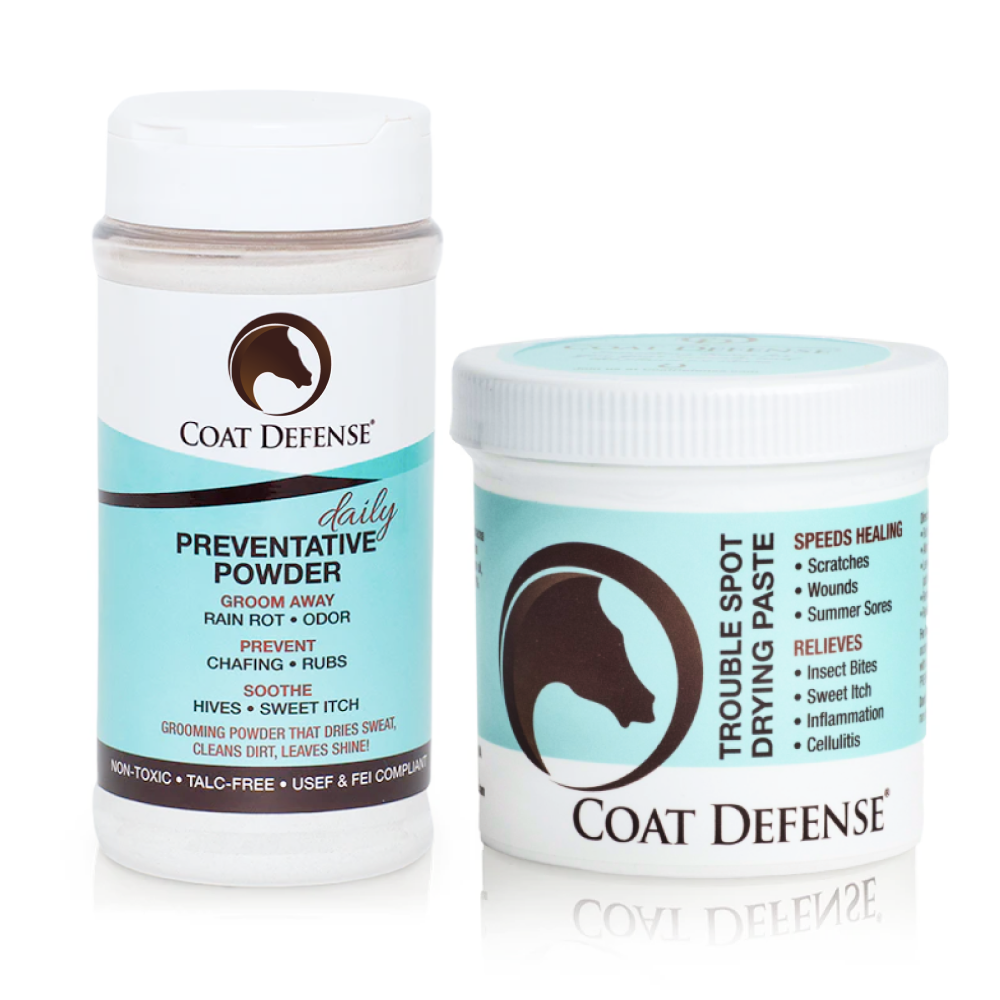If your horse has crusty scabs, hair-loss patches, or matted hair along the topline or rump after rainy or humid weather, you’re likely dealing with Dermatophilosis (commonly called “rain rot” or “rain scald”). This frequent equine skin ailment occurs when moisture, damaged skin, and bacteria team up to create an environment where infection thrives.
The good news? With the right approach, you can stop the cycle—and keep your horse’s skin healthy long-term.
Why Your Horse Keeps Getting Rain Rot & What to Do About It — Fast, Naturally
Why Rain Rot Keeps Happening
Rain rot happens when the skin’s natural barrier is broken down and the bacteria behind the condition (Dermatophilus congolensis) finds a moist, damaged space in which to thrive.
Key triggers include:
-
Prolonged wetness or humidity when the coat cannot dry properly.
-
Skin abrasions, insect bites, or saddle/blanket rubs that break the skin's protective layer.
-
Poor hygiene, shared grooming/tack tools, or heavy coats that trap moisture. Because the underlying conditions keep recurring, horse owners often get frustrated by repeat outbreaks.
How a Dry, Balanced Skin Barrier Stops the Cycle
To really stop rain rot you need more than just cleaning the scabs—you need to change the environment so the bacteria can’t thrive. That means keeping the skin dry, unbroken, and protected.
Enter the dry solution: our special powder designed to absorb excess moisture and create an unfriendly environment for the bacteria behind rain rot.
By regularly applying this powder to vulnerable areas—after baths, after turnout in damp conditions, or during humid seasons—you stop the source of infection rather than only treating the symptom.
Over time, healthier, stronger skin with a balanced microbiome is your best defense.
Gentle, Supportive Care Isn’t Caustic—It Heals
Many conventional treatments for rain rot rely on harsh chemicals, aggressive scrubbing or thorough removal of scabs. While sometimes necessary, these can damage the skin further weakening the barrier, disrupting natural oils, and making repeat infections more likely.
By contrast, a grooming routine that focuses on gentle cleansing, drying, and restoring the skin's ecosystem helps prevent recurrence. Think of it as nurturing the skin rather than attacking it.
And when you support the skin’s natural defenses and microbiome, you reduce the toxic load on the horse’s body and promote long-term wellness.
Your One-Step Routine to Kiss Rain Rot Goodbye
Step 1: Remedy the Rain Rot
Start with COAT DEFENSE® daily Preventative Powder.
Apply powder to any areas already showing early signs (matted hair, raised bumps, scabs)
-
This will create an environment rain rot can no longer thrive or survive in, eliminating it.
-
Draws out moisture, keeping the skin dry to support healing.
-
Continue to apply powder at least daily until healed. The more often you apply, the better.
It’s totally non-toxic, won’t sting, and can be used safely anywhere on your horse's body.
***For areas that are broken open like a wound, we recommend COAT DEFENSE® Trouble Spot Drying Paste
Tips to Keep Rain Rot GONE
-
After a bath or heavy turnout, use our moisture-absorbing powder on areas prone to rain rot: topline, shoulders, rump. Let it sit.
-
In damp, humid weather, apply the powder as a drying shield—preventing crusts, mats, or scabs from forming.
-
Ensure grooming tools, blankets and tack are cleaned and dried properly (shared gear spreads bacteria).
-
Maintain your horse’s skin health with a gentle, soothing shampoo like COAT DEFENSE® Sensitive Skin Horse Shampoo - free of harsh ingredients and designed to support skin recovery instead of stressing it further.
By combining gentle skincare, moisture control, and environmental management you break the feedback loop that leads to recurring rain rot.
Why This Works
-
The powder removes the moisture that bacteria need to multiply.
-
The skin barrier recovers, meaning fewer entry-points for infection.
-
Gentle products keep the skin microbiome intact and reduce the overall body stress of repeated flare-ups.
-
Preventative application means less downtime, less hair loss, fewer scabs and less discomfort.
Wrap-Up
If your horse keeps battling rain rot, remember: It’s not just about treating what you see—it’s about preventing what you don’t. Control the moisture, support the skin, and you stop the bacteria from ever getting a foothold.
With the right approach, your horse can have clean, healthy skin even in damp weather.
Ready to take action? Shop the horse-skin defense collection designed to stop rain rot for good and keep your horse’s coat shining, protected and comfortable.



